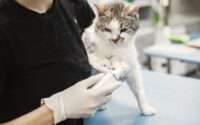How Many Puppies Can a Chihuahua Have? Prepare to Be Amazed!
Chihuahuas, with their big personalities and petite size, capture the hearts of many dog lovers. However, for Chihuahua owners, understanding their beloved pet’s reproductive cycle is essential. In this comprehensive guide, we delve into the fascinating world of Chihuahua pregnancy, exploring the factors that influence litter size and providing valuable insights for prospective Chihuahua owners and breeders.
Chihuahua Reproduction Basics
Before delving into the specifics of Chihuahua pregnancy, it’s essential to understand the basics of Chihuahua reproduction. Like all dogs, Chihuahuas follow a distinct reproductive cycle that includes mating, pregnancy, and whelping. Here’s an overview of the key stages:
- Mating Process: Chihuahuas typically reach sexual maturity between six months to a year of age, at which point they may enter their first heat cycle. During the mating process, male and female Chihuahuas come together for breeding, usually guided by their instinctual behaviors.
- Gestation Period: After successful mating, Chihuahuas enter the gestation period, which lasts approximately 58 to 63 days on average. During this time, the female Chihuahua undergoes significant physiological changes as she prepares to give birth to a litter of puppies.
- Signs of Pregnancy: Recognizing the signs of pregnancy in Chihuahuas is crucial for owners to provide appropriate care and support. Common signs include changes in appetite, weight gain, nesting behavior, and enlargement of the abdomen. Consulting with a veterinarian can confirm pregnancy through ultrasound or other diagnostic methods.
Learning about the fundamentals of Chihuahua reproduction sets the stage for exploring the factors influencing litter size and preparing for the arrival of Chihuahua puppies.
Factors Influencing Chihuahua Litter Size
The litter size of Chihuahuas can vary widely, influenced by several factors that range from genetics to environmental conditions. Here are some key factors to consider:
- Genetics: The genetic background of both the male and female Chihuahua plays a significant role in determining litter size. Dogs with larger litters in their ancestry are more likely to produce larger litters themselves.
- Health and Nutrition: A Chihuahua’s overall health and nutrition status before and during pregnancy can impact litter size. Proper pre-pregnancy care, including a balanced diet and regular veterinary check-ups, can help optimize the chances of a healthy litter.
- Age of the Chihuahua: The age of the Chihuahua at the time of breeding can also influence litter size. Generally, younger Chihuahuas may have smaller litters, while older dogs may have larger litters, although there are exceptions.
- Previous Breeding History: A Chihuahua’s previous breeding history can provide insights into their potential litter size. Dogs that have produced large litters in the past are more likely to do so again, while those with a history of small litters may continue that pattern.
- Environmental Factors: Environmental factors, such as stress levels and living conditions, can impact a Chihuahua’s reproductive health and litter size. Providing a calm and supportive environment during pregnancy can help optimize litter size and ensure the well-being of both the mother and her puppies.
Understanding these factors can help Chihuahua owners and breeders make informed decisions and take proactive steps to support healthy pregnancies and optimal litter sizes.
How Many Puppies Can a Chihuahua Have?
While Chihuahuas are known for their small size, their litter sizes can vary widely. On average, Chihuahuas typically have litters ranging from one to six puppies, with three to four puppies being the most common. However, it’s essential to remember that individual variation exists, and some Chihuahuas may have larger or smaller litters.
Factors such as genetics, health, age, and previous breeding history all play a role in determining the litter size of Chihuahuas. Additionally, environmental factors and proper prenatal care can impact litter size and the health of the mother and her puppies.
Chihuahua owners and breeders should be prepared for the possibility of varying litter sizes and ensure they have the resources and support needed to care for the mother and her puppies during and after whelping.
Risks and Considerations During Chihuahua Pregnancy
During Chihuahua pregnancy, it’s essential for owners to be aware of potential risks and considerations to ensure the health and well-being of the mother and her puppies. Here are some key points to keep in mind:
- Potential Complications: Chihuahua pregnancies, like any pregnancy, can be associated with various complications. These may include issues such as eclampsia (milk fever), dystocia (difficult birth), or pregnancy loss. It’s crucial for owners to monitor the mother closely for any signs of distress or complications and seek veterinary care if needed.
- Prenatal Care: Providing proper prenatal care for the expectant Chihuahua mother is essential for promoting a healthy pregnancy and reducing the risk of complications. This includes regular veterinary check-ups, a balanced diet, and appropriate supplementation as recommended by a veterinarian.
- Nutrition and Hydration: Maintaining proper nutrition and hydration is crucial during Chihuahua pregnancy. Pregnant Chihuahuas may have increased nutritional needs, particularly during the later stages of pregnancy and while nursing. Owners should consult with their veterinarian to ensure the mother receives adequate nutrients and stays hydrated throughout the pregnancy.
- Monitoring for Signs of Labor: As the pregnancy progresses, owners should monitor the expectant mother for signs of impending labor. These may include nesting behavior, restlessness, temperature drop, and loss of appetite. Being prepared for labor and delivery ensures a smooth transition for both the mother and her puppies.
- Emergency Preparedness: In case of emergency, owners should have a plan in place and be prepared to seek veterinary assistance if needed. This includes having emergency contact information readily available and knowing the signs of complications that require immediate medical attention.
By being aware of potential risks and considerations during Chihuahua pregnancy, owners can take proactive steps to promote a healthy and successful outcome for both the mother and her puppies.
Preparing for a Chihuahua Litter
Preparing for a Chihuahua litter involves careful planning and consideration to ensure the well-being of the mother and her puppies. Here are some essential steps to take:
- Creating a Whelping Area: Designate a quiet, comfortable area for the expectant mother to give birth and care for her puppies. This area should be warm, clean, and free from distractions, providing a safe space for the mother and her newborns.
- Gathering Necessary Supplies: Stock up on essential supplies for whelping and caring for Chihuahua puppies. This may include whelping boxes, bedding, heat lamps or heating pads, scales for weighing puppies, and emergency supplies for any potential complications.
- Educating Yourself: Educate yourself on the birthing process and what to expect during labor and delivery. Familiarize yourself with signs of labor, stages of labor, and potential complications that may arise. Being prepared and informed allows you to provide the necessary support and assistance to the mother during whelping.
- Seeking Veterinary Guidance: Consult with your veterinarian for guidance and support throughout the pregnancy and whelping process. Your veterinarian can provide valuable advice on prenatal care, labor management, and newborn puppy care, ensuring the best possible outcome for the mother and her puppies.
With these proactive steps to prepare for a Chihuahua litter, owners can help ensure a smooth and successful birthing experience and promote the health and well-being of the mother and her puppies.
Whelping and Caring for Chihuahua Puppies
Whelping, the process of giving birth to puppies, is a crucial moment for both the Chihuahua mother and her newborns. Here’s what to expect during whelping and how to care for Chihuahua puppies:
- Signs of Impending Labor: As the due date approaches, the expectant mother may exhibit nesting behavior, restlessness, and a decrease in body temperature. These signs indicate that labor is imminent, and owners should prepare for the birthing process accordingly.
- Assistance During Labor: During labor, owners should provide a supportive environment for the mother and be prepared to assist if necessary. This may involve offering encouragement, providing comfort measures such as gentle massage, and monitoring the progress of labor.
- Newborn Puppy Care: After birth, it’s essential to provide immediate care to the newborn puppies. This includes removing the birth sac, clearing their airways, and ensuring they are breathing and nursing properly. Keeping the puppies warm and dry is also crucial during the first few hours of life.
- Monitoring and Weighing Puppies: Regular monitoring and weighing of the puppies are essential to ensure they are growing and thriving. Owners should keep track of each puppy’s weight gain and monitor for any signs of illness or developmental issues.
- Nutrition and Nursing: The mother’s milk provides essential nutrients and antibodies that support the puppies’ growth and immune system. Owners should ensure the mother receives a nutritious diet and has access to plenty of fresh water to support milk production.
- Socialization and Handling: Early socialization and handling are critical for Chihuahua puppies’ development. Owners should gently handle and interact with the puppies from an early age to help them become well-adjusted and socialized adults.
- Healthcare and Vaccinations: Puppies should receive appropriate veterinary care, including vaccinations and deworming, as recommended by a veterinarian. Regular veterinary check-ups are essential to monitor the puppies’ health and development as they grow.
Owners play a vital role in ensuring the health and well-being of both the Chihuahua mother and her puppies during whelping and throughout the early weeks of their lives. Through attentive care and support, owners can make a significant difference in the overall welfare of their furry family members.
Responsible Breeding Practices for Chihuahuas
Responsible breeding practices are essential for maintaining the health and integrity of the Chihuahua breed. Here are some key considerations for Chihuahua breeders:
- Health Screening: Before breeding, Chihuahua parents should undergo thorough health screening to identify any hereditary health issues that could be passed on to their offspring. This may include genetic testing for conditions such as patellar luxation, cardiac abnormalities, and eye diseases.
- Selective Breeding: Breeders should carefully select breeding pairs based on their health, temperament, and conformation to breed standards. This helps ensure that the puppies are healthy, sound, and representative of the breed standard.
- Breeding Age and Frequency: Chihuahuas should only be bred once they have reached physical and mental maturity, typically around 18 to 24 months of age. Breeding should be done responsibly and with consideration for the mother’s health and well-being, avoiding excessive breeding that could compromise her health.
- Ethical Placement of Puppies: Responsible breeders are committed to finding suitable homes for their puppies and ensuring they receive proper care and socialization. They carefully screen potential buyers and provide ongoing support and guidance to puppy owners.
- Education and Advocacy: Responsible breeders are advocates for the Chihuahua breed and work to educate the public about responsible dog ownership, breed characteristics, and health considerations. They are committed to preserving and protecting the breed for future generations.
By adhering to responsible breeding practices, Chihuahua breeders can help ensure the health, well-being, and long-term viability of the breed.
Conclusion
In conclusion, the journey of Chihuahua pregnancy and whelping is a remarkable and rewarding experience for both owners and their beloved pets. From the excitement of discovering a pregnancy to the joy of welcoming a litter of tiny puppies into the world, each moment is filled with love, anticipation, and wonder.
By understanding the factors influencing litter size, preparing for the arrival of Chihuahua puppies, and adhering to responsible breeding practices, owners can ensure the health and well-being of both the mother and her puppies. Through attentive care, support, and dedication, Chihuahua owners can help their furry companions thrive and create cherished memories that will last a lifetime.
As we celebrate the magic of Chihuahua pregnancy and whelping, let us embrace the joy and wonder of new beginnings and cherish the special bond that unites us with our beloved Chihuahuas.
Frequently Asked Questions
How many puppies can a Chihuahua have in a litter?
The average litter size for Chihuahuas typically ranges from one to six puppies, with three to four puppies being the most common.
What factors influence the number of puppies a Chihuahua can have?
Several factors can influence litter size in Chihuahuas, including genetics, health, age, previous breeding history, and environmental conditions.
What should I do if my Chihuahua is pregnant?
If your Chihuahua is pregnant, it’s essential to provide proper prenatal care, including regular veterinary check-ups, a balanced diet, and a comfortable environment for whelping.
How long is the gestation period for Chihuahuas?
The gestation period for Chihuahuas is approximately 58 to 63 days, with variations depending on individual factors.
What are the signs of impending labor in Chihuahuas?
Signs of impending labor in Chihuahuas may include nesting behavior, restlessness, a drop in body temperature, and loss of appetite.
What should I do if my Chihuahua experiences complications during pregnancy or labor?
If your Chihuahua experiences complications during pregnancy or labor, seek immediate veterinary care to ensure the health and well-being of the mother and her puppies.
How should I prepare for the arrival of Chihuahua puppies?
Prepare for the arrival of Chihuahua puppies by creating a comfortable whelping area, gathering necessary supplies, and educating yourself on the birthing process.
What should I feed my Chihuahua during pregnancy and lactation?
During pregnancy and lactation, it’s essential to provide your Chihuahua with a nutritious diet formulated for pregnant and nursing dogs, as recommended by your veterinarian.
How can I help my Chihuahua care for her puppies after birth?
Provide support to your Chihuahua during whelping and help her care for her puppies by monitoring their health, ensuring they are nursing properly, and providing a warm and safe environment.
What are responsible breeding practices for Chihuahuas?
Responsible breeding practices for Chihuahuas include health screening, selective breeding, proper care and socialization of puppies, and advocacy for the breed’s well-being.





Hey there! Someone in my Facebook group shared this site with us so I came to look
it over. I’m definitely enjoying the information. I’m book-marking and will be tweeting this to my
followers! Terrific blog and wonderful design.
Ahaa, its nice discussion concerning this article at
this place at this webpage, I have read all that,
so now me also commenting here.